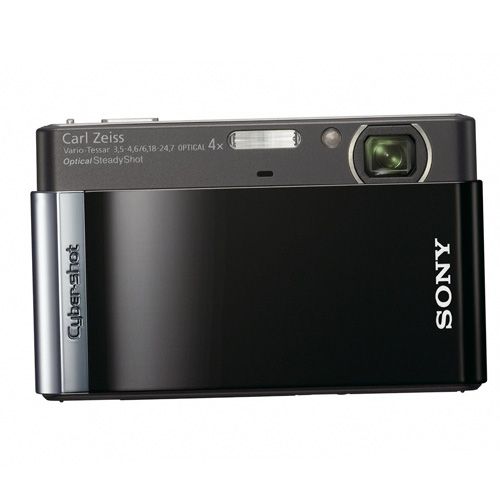Sony’s latest snapshot, the DSC-T90, takes up the gauntlet thrown down by its predecessors and delivers beauty and simplicity married to almost anorexic proportions. No wonder it’s referred to as a "fashion" model, here boasting a maximum width of a mere 15.1mm, weighing just 151g with battery inserted, and operated by basically sliding open its faceplate and pointing the lens in the right direction.
Our quick take
Small enough to carry in a pocket at all times, the T90 suggests itself as the ideal purchase for the happy snapper wanting better quality results than a camera phone will presently provide. It looks good too, even though Sony’s designers seem to be resting on their laurels rather than attempting to enhance the range further and little has changed from previous incarnations.
Incidentally, if, like we do, you feel a larger 3.5-inch touchscreen would be advantageous, then the T500 was at the time of writing available for an identical outlay.

Sony Cyber-shot DSC-T90 digital camera - 3.5 / 5
| FOR | AGAINST |
|---|---|
|
|
Brushing aside for the moment the observation that the T90 doesn’t offer a great deal more than its T77 and T500 predecessors - except (granted) a resolution hike to 12 megapixels - what we do get is an internally stacked 4x optical zoom with a 35-140mm 35mm equivalent range plus renowned Carl Zeiss optics, High Definition 1280 x 720 video clips, and 3-inch widescreen-format touchscreen LCD with 230k dot resolution. Even so, the £289 asking price marks this out as a premium model rather than a value added one.
Though less of a big deal these days thanks to the ubiquitous iPhone, the Sony’s touchscreen takes a little getting used to. A plastic stylus that attaches to the wrist strap is provided as a means of tapping and selecting cartoon-ish on-screen icons, which in turn provide access to fold-out or drop-down toolbars, the latter cropping the screen if shooting regular 4:3 ratio snaps rather than 16:9. If that proves too fiddly then a fingertip works just as well, albeit leaving smears on the glass.
With the T90 feeling lightweight yet solid when held in the palm thanks to a mainly metal construction, the screen itself is pleasantly responsive to every prod and effects an action with impressive speed.
At times however the options presented can get a little busy for its LCD size - particularly if shooting in the more extensive program mode. There is however a pared down easy mode, plus an "auto everything" intelligent auto (iA) mode that automatically analyses the scene or subject and adjusts settings accordingly. So, point the camera at something close and it will select macro mode, affording focus down to 8cm from the lens, with 10 other possible options for it to choose from.
If wanting to concentrate on your composition rather than what the camera is doing, then this is the mode to choose. That said, at times our review sample was a little lethargic in distinguishing one scene and setting from the next. More positively, we were up and shooting fairly quickly, a wait of around 2 seconds and a musical "sting" as the camera powers up from cold.
With the only physical controls being a shutter release button, on/off button, tiny rocker switch for the zoom and a playback button at the back, what the T90 misses is an HDMI port for connecting it directly to an HD TV set. Regular AV out and USB 2.0 connections are present and correct, accessed with the aid of a multi-purpose cable included in the box.
Given the fact that this pocket camera puts as much emphasis on style as substance we were pleased to find that light sensitivity of up to ISO 3200 is manually selectable, and that optical image stabilisation is also included, here under the "SteadyShot" branding. Useful, as with a narrow screen surround there’s not much of the model presented to get a firm grip on, thus camera shake can seem more pronounced.
At its top ISO setting the T90 doesn't do a bad job, the level of grain/image noise visible being comparable to that witnessed at ISO 1600 from a 10 or 12 megapixel snapper around the £120 mark, and so it proves progressing incrementally down the range.
In terms of stills quality, left on its factory settings the camera produces subdued yet natural looking colours, with a vivid option selectable for added richness. Given that previous generations of Sony’s have suffered from obvious pixel fringing, here such aberrations are kept under control and, as mentioned earlier, the auto scene modes work well, particularly when the camera selects the green and blue biasing landscape mode.
It may not excel at one thing in particular but the T90 works as a general-purpose tool for occasional use for those who don’t want to fuss around with settings.
To recap
Though priced at a premium, for those who value both style and substance the T90 makes for a happy compromise, if no great advancement from previous Cyber-shots
